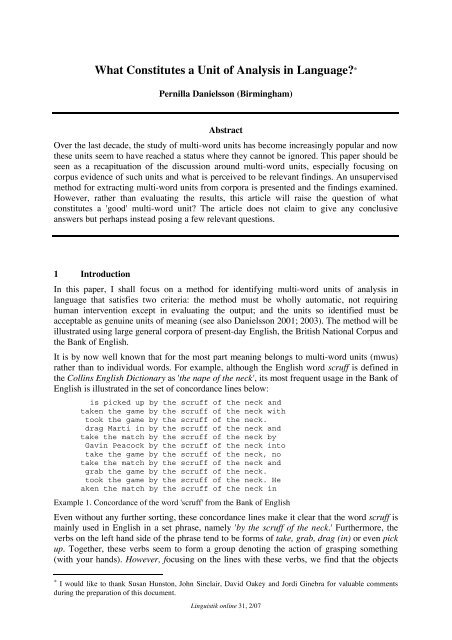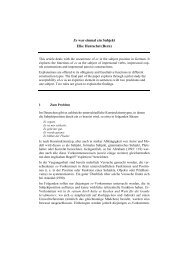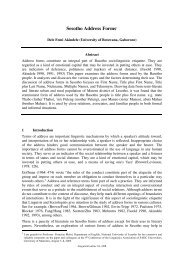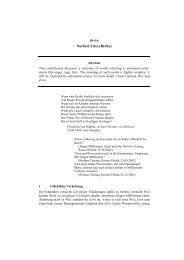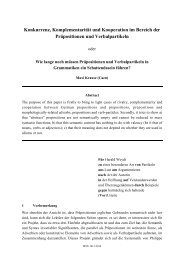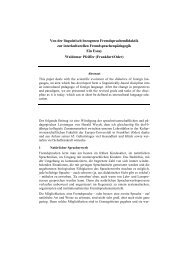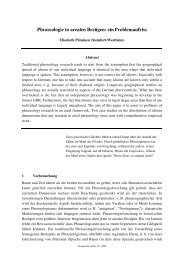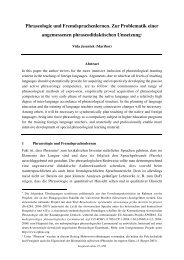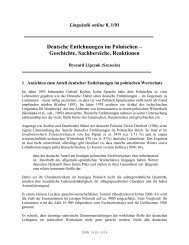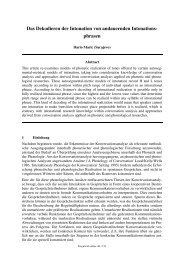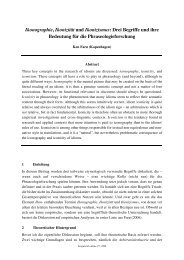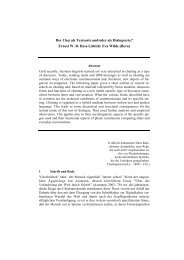What Constitutes a Unit of Analysis in Language?* - Linguistik online
What Constitutes a Unit of Analysis in Language?* - Linguistik online
What Constitutes a Unit of Analysis in Language?* - Linguistik online
You also want an ePaper? Increase the reach of your titles
YUMPU automatically turns print PDFs into web optimized ePapers that Google loves.
<strong>What</strong> <strong>Constitutes</strong> a <strong>Unit</strong> <strong>of</strong> <strong>Analysis</strong> <strong>in</strong> <strong>Language</strong>? *Pernilla Danielsson (Birm<strong>in</strong>gham)AbstractOver the last decade, the study <strong>of</strong> multi-word units has become <strong>in</strong>creas<strong>in</strong>gly popular and nowthese units seem to have reached a status where they cannot be ignored. This paper should beseen as a recapituation <strong>of</strong> the discussion around multi-word units, especially focus<strong>in</strong>g oncorpus evidence <strong>of</strong> such units and what is perceived to be relevant f<strong>in</strong>d<strong>in</strong>gs. An unsupervisedmethod for extract<strong>in</strong>g multi-word units from corpora is presented and the f<strong>in</strong>d<strong>in</strong>gs exam<strong>in</strong>ed.However, rather than evaluat<strong>in</strong>g the results, this article will raise the question <strong>of</strong> whatconstitutes a 'good' multi-word unit? The article does not claim to give any conclusiveanswers but perhaps <strong>in</strong>stead pos<strong>in</strong>g a few relevant questions.1 IntroductionIn this paper, I shall focus on a method for identify<strong>in</strong>g multi-word units <strong>of</strong> analysis <strong>in</strong>language that satisfies two criteria: the method must be wholly automatic, not requir<strong>in</strong>ghuman <strong>in</strong>tervention except <strong>in</strong> evaluat<strong>in</strong>g the output; and the units so identified must beacceptable as genu<strong>in</strong>e units <strong>of</strong> mean<strong>in</strong>g (see also Danielsson 2001; 2003). The method will beillustrated us<strong>in</strong>g large general corpora <strong>of</strong> present-day English, the British National Corpus andthe Bank <strong>of</strong> English.It is by now well known that for the most part mean<strong>in</strong>g belongs to multi-word units (mwus)rather than to <strong>in</strong>dividual words. For example, although the English word scruff is def<strong>in</strong>ed <strong>in</strong>the Coll<strong>in</strong>s English Dictionary as 'the nape <strong>of</strong> the neck', its most frequent usage <strong>in</strong> the Bank <strong>of</strong>English is illustrated <strong>in</strong> the set <strong>of</strong> concordance l<strong>in</strong>es below:is picked up by the scruff <strong>of</strong> the neck andtaken the game by the scruff <strong>of</strong> the neck withtook the game by the scruff <strong>of</strong> the neck.drag Marti <strong>in</strong> by the scruff <strong>of</strong> the neck andtake the match by the scruff <strong>of</strong> the neck byGav<strong>in</strong> Peacock by the scruff <strong>of</strong> the neck <strong>in</strong>totake the game by the scruff <strong>of</strong> the neck, notake the match by the scruff <strong>of</strong> the neck andgrab the game by the scruff <strong>of</strong> the neck.took the game by the scruff <strong>of</strong> the neck. Heaken the match by the scruff <strong>of</strong> the neck <strong>in</strong>Example 1. Concordance <strong>of</strong> the word 'scruff' from the Bank <strong>of</strong> EnglishEven without any further sort<strong>in</strong>g, these concordance l<strong>in</strong>es make it clear that the word scruff isma<strong>in</strong>ly used <strong>in</strong> English <strong>in</strong> a set phrase, namely 'by the scruff <strong>of</strong> the neck.' Furthermore, theverbs on the left hand side <strong>of</strong> the phrase tend to be forms <strong>of</strong> take, grab, drag (<strong>in</strong>) or even pickup. Together, these verbs seem to form a group denot<strong>in</strong>g the action <strong>of</strong> grasp<strong>in</strong>g someth<strong>in</strong>g(with your hands). However, focus<strong>in</strong>g on the l<strong>in</strong>es with these verbs, we f<strong>in</strong>d that the objects* I would like to thank Susan Hunston, John S<strong>in</strong>clair, David Oakey and Jordi G<strong>in</strong>ebra for valuable commentsdur<strong>in</strong>g the preparation <strong>of</strong> this document.L<strong>in</strong>guistik onl<strong>in</strong>e 31, 2/07
18L<strong>in</strong>guistik onl<strong>in</strong>e 31, 2/07associated with take by the scruff <strong>of</strong> the neck are most <strong>of</strong>ten a game, a match or even anopportunity. In fact, <strong>in</strong> the Bank <strong>of</strong> English corpus there is only one occurrence <strong>in</strong> the corpus<strong>of</strong> a dog be<strong>in</strong>g picked up by the scruff <strong>of</strong> his neck, <strong>in</strong> which case scruff does refer to 'the nape<strong>of</strong> the neck' as it is def<strong>in</strong>ed by CED. All the other occurrences have the different usageillustrated above, which only becomes obvious when view<strong>in</strong>g the repetitive patterns <strong>of</strong>language data through a concordance program.There has been a huge growth <strong>of</strong> <strong>in</strong>terest <strong>in</strong> phenomena such as this <strong>in</strong> recent years. Althoughit has long been known that words are distributed non-randomly <strong>in</strong> text, and that this nonrandomdistribution carries <strong>in</strong>formation about mean<strong>in</strong>g (Firth 1951/1957; de Saussure1918/1959), it is only more recently that l<strong>in</strong>guists have taken the implications <strong>of</strong> this seriouslyand have extended their <strong>in</strong>vestigations <strong>in</strong>to multi-word units beyond the traditional categories<strong>of</strong> phrasal verbs, nom<strong>in</strong>al compounds, and idioms. The popularity <strong>of</strong> the term 'pattern', for<strong>in</strong>stance, is evidenced by the many corpus studies that <strong>in</strong>clude 'pattern' <strong>in</strong> their title (forexample, Hunston/Francis 1999; Part<strong>in</strong>gton 1998; Hoey 1991). Interest <strong>in</strong> multi-word unitshas also grown, but with this popularity the number <strong>of</strong> ways to refer to them has also<strong>in</strong>creased. References to lexical items, units <strong>of</strong> mean<strong>in</strong>g (S<strong>in</strong>clair 1996), formulaic sequences(Schmitt 2004; Wray 2002), multi-word expressions (ACL proceed<strong>in</strong>gs 2004), semipreconstructedphrases (S<strong>in</strong>clair 1991: 110) and prefabricated units (Erman/Warren 2000),can be used to show how heterogeneous the field is. The lack <strong>of</strong> uniform term<strong>in</strong>ology may bejust one <strong>of</strong> many clues to the confusion, and to the need for further research, <strong>in</strong> this area.Although the importance <strong>of</strong> multi-word units is accepted, there are no accepted answers tosimple questions such as "<strong>What</strong> exactly constitutes a multi-word unit?" or "Where does amulti-word unit beg<strong>in</strong> and end?"The identification <strong>of</strong> mwus poses a problem for corpus l<strong>in</strong>guistics and computationall<strong>in</strong>guistics alike, <strong>in</strong> that whereas recurr<strong>in</strong>g sequences <strong>of</strong> words can be identified easily, suchsequences are unlikely to co<strong>in</strong>cide exactly with what a human researcher would accept as a'unit <strong>of</strong> mean<strong>in</strong>g' <strong>in</strong> a language. Unless this problem is addressed, computational l<strong>in</strong>guistics <strong>in</strong>particular will f<strong>in</strong>d it difficult to embrace <strong>in</strong>sights <strong>in</strong>to language that prioritise mean<strong>in</strong>g ratherthan structure (e.g. S<strong>in</strong>clair 1991; 2004). As many <strong>of</strong> the applications <strong>of</strong> computationall<strong>in</strong>guistics, such as text-m<strong>in</strong><strong>in</strong>g, also prioritise mean<strong>in</strong>g, this amounts to a missed opportunity.There are <strong>in</strong> existence a number <strong>of</strong> algorithms for the identification <strong>of</strong> multi-word units,<strong>in</strong>clud<strong>in</strong>g for example Piao et al. (2005), Mason (2006), Smadja (1989, 1993) and Diaz et al.(1999, 2005). All, however, face difficulties because <strong>of</strong> the mismatch between what computerprograms can easily do and what mwus are like. Firstly, recurr<strong>in</strong>g sequences <strong>of</strong> words can beidentified if their length is specified <strong>in</strong> advance, as when bigrams or trigrams are extractedfrom a corpus. There is no reason to suppose, however, that these preset sequence lengths willmap on to actual language units, and <strong>in</strong>deed as research cont<strong>in</strong>ues it becomes apparent thatthere is no length specification to units <strong>of</strong> mean<strong>in</strong>g, so that sett<strong>in</strong>g a sequence length <strong>in</strong>advance becomes counter-productive. Secondly, recurr<strong>in</strong>g sequences by themselves do notallow for discont<strong>in</strong>uous sequences, although it is well known that most units (e.g. keep an eyeon someth<strong>in</strong>g) allow for <strong>in</strong>terpolation (e.g. keep a watchful eye on someth<strong>in</strong>g) among othermodifications (see Moon 1998). F<strong>in</strong>ally, many computational approaches apply statisticalsignificance measurements such as t-score, MI and log-likelihood, although it is uncerta<strong>in</strong>what these statistics mean <strong>in</strong> the context <strong>of</strong> a non-random system such as language. Theirapplication to the identification <strong>of</strong> mwus, therefore, is <strong>of</strong> questionable value.The aim <strong>of</strong> the method described <strong>in</strong> this paper, then, is to identify units <strong>of</strong> mean<strong>in</strong>g <strong>in</strong>monol<strong>in</strong>gual corpora, assum<strong>in</strong>g neither unit length nor sequentiality, and us<strong>in</strong>g only rawfrequency as the statistical tool. The method will be outl<strong>in</strong>ed <strong>in</strong> the next section. The f<strong>in</strong>d<strong>in</strong>gsISSN 1615-3014
Pernilla Danielsson: <strong>What</strong> constitutes a unit <strong>of</strong> analysis <strong>in</strong> language?19from this section will be used as a start<strong>in</strong>g po<strong>in</strong>t for a brief discussion on whether human<strong>in</strong>tuition and corpus data agree on what constitutes a multi-word unit.2 Towards the identification <strong>of</strong> mean<strong>in</strong>gful unitsThe methodology presented <strong>in</strong> this paper follows a very simple sequence <strong>of</strong> actions. First, alloccurrences <strong>of</strong> the target node word (N) are identified <strong>in</strong> a large corpus and the most frequentcollocate <strong>of</strong> the node (F1) is calculated with<strong>in</strong> a span <strong>of</strong> 9 words (i.e. 4 words to the right and4 to the left <strong>of</strong> N) 'Function' words are discarded. (They are identified by hav<strong>in</strong>g an arbitrarycut-<strong>of</strong>f po<strong>in</strong>t at a high position <strong>in</strong> the overall word frequency list for the corpus <strong>in</strong> question).Then all the l<strong>in</strong>es which conta<strong>in</strong> both N and F1 are selected, irrespective <strong>of</strong> the position <strong>of</strong> F1relative to N. Tak<strong>in</strong>g just those l<strong>in</strong>es, the most frequent word <strong>in</strong> them (apart from N and F1) isidentified as F2. The process is repeated until occurrences <strong>of</strong> the new collocate identified fallto below 5 (an arbitrary cut-<strong>of</strong>f po<strong>in</strong>t that may need to be revised). The procedure will now beillustrated us<strong>in</strong>g the word jam <strong>in</strong> the British National Corpus (BNC). First, all theconcordance l<strong>in</strong>es with the word jam as node are identified. From these l<strong>in</strong>es the mostfrequent collocates <strong>of</strong> the node are calculated and the function words dismissed. The mostfrequent collocates thus identified are:trafficbreadjarsbutterstrawberryjarExample 2. The list <strong>of</strong> the most frequent collocates around jamFor each <strong>of</strong> these collocates, concordance l<strong>in</strong>es for the node and the collocate, where thecollocate occurs with<strong>in</strong> a span <strong>of</strong> 4+4 words are generated, start<strong>in</strong>g with 'traffic'.grimmest traffic jam seems better thman <strong>in</strong> a traffic jam who curses allnsport. a traffic jam <strong>in</strong> swansea.n enormous traffic jam, and it lookedstuck <strong>in</strong> a traffic jam with your pulsestuck <strong>in</strong> a traffic jam or be<strong>in</strong>g promo.ise every traffic jam will graduallystuck <strong>in</strong> a traffic jam with their entt<strong>in</strong>g <strong>in</strong> a traffic jam with such a carit<strong>in</strong>g <strong>in</strong> a traffic jam. that driveralter the traffic jam <strong>in</strong> the slightest.Example 3. Concordance for jam and trafficAlthough the relative positions <strong>of</strong> traffic and jam were not specified, it is already clear that themost common position <strong>of</strong> traffic is one to the left <strong>of</strong> jam. A new calculation is now made, thistime <strong>in</strong>clud<strong>in</strong>g all words, to f<strong>in</strong>d the most frequent collocate (F2) <strong>in</strong> the l<strong>in</strong>es that <strong>in</strong>clude bothtraffic and jam. It is the word 'a'. The concordance l<strong>in</strong>es <strong>in</strong>clud<strong>in</strong>g the node word, jam, thefirst collocate, traffic, and the second collocate, a are now generated.These concordance l<strong>in</strong>es <strong>in</strong> turn are processed to identify the next most frequent collocate,exclud<strong>in</strong>g the words already selected. The new collocate (F3) is <strong>in</strong>. As there are still morethan 62 concordance l<strong>in</strong>es, we may cont<strong>in</strong>ue to f<strong>in</strong>d yet another frequent collocate with<strong>in</strong>these l<strong>in</strong>es. The word stuck occurs 9 times. Here, we ran out <strong>of</strong> data to cont<strong>in</strong>ue, as no othercollocate occurs frequently enough to be <strong>in</strong>cluded. Example 4 shows the concordance l<strong>in</strong>esthat <strong>in</strong>clude the node jam and F1, F2, F3 and F4: traffic, a, <strong>in</strong> and stuck.ISSN 1615-3014
20L<strong>in</strong>guistik onl<strong>in</strong>e 31, 2/07stuck <strong>in</strong> a traffic jam the other day.stuck <strong>in</strong> a traffic jam with your pulse racistuck <strong>in</strong> a traffic jam or be<strong>in</strong>g promoted.stuck <strong>in</strong> a traffic jam with their eng<strong>in</strong>esstuck <strong>in</strong> a traffic jam, and can't letstuck <strong>in</strong> a traffic jam <strong>in</strong> the back <strong>of</strong>stuck <strong>in</strong> a traffic jam, however , andstuck <strong>in</strong> a traffic jam, you might reflectstuck <strong>in</strong> a traffic jam? not a lotExample 4. Concordance for 'stuck <strong>in</strong> a traffic jam'From here, no other collocates occur with sufficient frequency to reach the cut-<strong>of</strong>f po<strong>in</strong>t, andwe may claim to have achieved the maximal unit based on the distribution <strong>in</strong> this corpus.Once the collocates are gathered, the next step is to order them sequentially. In this case it hasbeen clear from the start that they will only present themselves <strong>in</strong> one order 'stuck <strong>in</strong> a trafficjam', however, other units may allow more variation <strong>in</strong> sequence.When a unit and the order <strong>of</strong> words has been established, the next step is to test for variations.Two types <strong>of</strong> variation may be identified: syntagmatic and paradigmatic variations. Thesyntagmatic variations come <strong>in</strong> the form <strong>of</strong> modify<strong>in</strong>g words <strong>in</strong> between each <strong>of</strong> the words <strong>in</strong>the unit, as <strong>in</strong> 'a stroke <strong>of</strong> luck' and 'a great stroke <strong>of</strong> luck'. In the worked example here,<strong>in</strong>tuition suggestions alternatives such as 'stuck <strong>in</strong> a hellish traffic jam'. However, these arenot present <strong>in</strong> the BNC corpus so <strong>in</strong> the case here, we have no syntagmatic variations.For paradigmatic variations, each word <strong>in</strong> the unit is tested to see if the unit allows foralternatives. For example, the corpus is searched to identify which other words can be found<strong>in</strong> the position <strong>of</strong> 'stuck'when followed by the exact phrase '<strong>in</strong> a traffic jam'. The corpus <strong>of</strong>fersstuck, sitt<strong>in</strong>g, wait<strong>in</strong>g, and caught. In this particular context, the words seem to be related and<strong>of</strong>fer a set <strong>of</strong> verbs that create a feel<strong>in</strong>g associated with the annoy<strong>in</strong>g event <strong>of</strong> be<strong>in</strong>g held up <strong>in</strong>traffic. It should be noted that this association is context-dependent: <strong>in</strong> other contexts, stuck,sitt<strong>in</strong>g, wait<strong>in</strong>g and caught would not be seen as a set <strong>of</strong> related words.The next word to test for paradigmatic variation is <strong>in</strong>. Here, no variation is apparent. In thesequence 'stuck x a traffic jam', x is always <strong>in</strong>. The same is true <strong>of</strong> 'a'. Interest<strong>in</strong>gly, it appearsthat this is most <strong>of</strong>ten the case for the high-frequency words. They are <strong>of</strong>ten said to providestructure rather than mean<strong>in</strong>g, and as such they seem to object to modification and variation.There are no variations for the word traffic either, , but the last variation test, for the word jamitself, gives a few alternatives, namely nightmare and queue. Aga<strong>in</strong>, these are two wordswhich are not normally seen as form<strong>in</strong>g a set with jam, but <strong>in</strong> this unit they count as viablevariations.The methodology presented here has previously been illustrated <strong>in</strong> Danielsson (2003) and wasfirst <strong>in</strong>troduced <strong>in</strong> Danielsson (2001). Here, it has been altered <strong>in</strong> some ways. In previouspublications, the downward/upward dist<strong>in</strong>ction <strong>of</strong> collocates was used with the cut-<strong>of</strong>f po<strong>in</strong>tset at the frequency <strong>of</strong> the node word. In this study, the cut-<strong>of</strong>f po<strong>in</strong>t is set at a higherfrequency. The orig<strong>in</strong>al argument for us<strong>in</strong>g the frequency <strong>of</strong> the node word as the cut-<strong>of</strong>fpo<strong>in</strong>t lies <strong>in</strong> the assumption that less frequent words carry more mean<strong>in</strong>g. Hence any collocateappear<strong>in</strong>g less frequently than the node word can be expected to carry more mean<strong>in</strong>g. Such anapproach assumes that the entire vocabulary <strong>of</strong> a corpus will be run through the s<strong>of</strong>tware;certa<strong>in</strong>ly a lengthy process. This has here been replaced by a simpler assumption, mak<strong>in</strong>g anarbitrary cut-<strong>of</strong>f at a po<strong>in</strong>t which may symbolise the dist<strong>in</strong>ction between function words andcontent words. For further discussion on this matter, see Danielsson (2001).ISSN 1615-3014
Pernilla Danielsson: <strong>What</strong> constitutes a unit <strong>of</strong> analysis <strong>in</strong> language?213 Jam: a few case studiesThis section will be used to <strong>in</strong>vestigate further some <strong>of</strong> the units retrieved by the methodology<strong>in</strong>troduced above. Due to space limitations only a few will be mentioned. We will beg<strong>in</strong> bylook<strong>in</strong>g at units <strong>in</strong>clud<strong>in</strong>g the F1 collocate 'jar/s', as this word occurred both <strong>in</strong> s<strong>in</strong>gular andplural form <strong>in</strong> the list <strong>in</strong> example 2.From the OED (1999), we f<strong>in</strong>d that one def<strong>in</strong>ition <strong>of</strong> jam is:A conserve <strong>of</strong> fruit prepared by boil<strong>in</strong>g it with sugar to a pulpThe action <strong>of</strong> jamm<strong>in</strong>g, the fact or condition <strong>of</strong> be<strong>in</strong>g jammed, or tightly packed orsqueezed, so as to prevent movement; a crush, a squeezeThis def<strong>in</strong>ition might be considered relevant <strong>in</strong> concordance l<strong>in</strong>es that <strong>in</strong>clud<strong>in</strong>g jam and itsF1 collocate jar.catch<strong>in</strong>g bees <strong>in</strong> a jam jar, fly swatt<strong>in</strong>gre was a candle <strong>in</strong> a jam-jar on the locker.from a candle <strong>in</strong> a jam jar to electric licplonk a candle <strong>in</strong> a jam jar, it is worth ta<strong>of</strong> wild flowers <strong>in</strong> a jam jar. There are slateWild Flowers <strong>in</strong> a Jam Jar). And 18 monthsand place them <strong>in</strong> a jam jar, porcela<strong>in</strong> bowl,nd puts them <strong>in</strong> her jam jar. She has aboutch<strong>in</strong>g tiddlers <strong>in</strong> a jam jar at the canal.hornet trapped <strong>in</strong> a jam-jar. ROC's `Deadbit like a wasp <strong>in</strong> a jam jar. Davis: Butg up like a wasp <strong>in</strong> a jam jar." When I went,petals and water <strong>in</strong> a jam jar. It'd be wornspit from a zoo <strong>in</strong> a jam jar. He said: 'ThisExample 5. Concordances <strong>of</strong> 'jam jar'Interest<strong>in</strong>gly, however, <strong>in</strong> the jam jar concordance above, the mean<strong>in</strong>g <strong>of</strong> jam as def<strong>in</strong>ed <strong>in</strong>the OED has disappeared. There is no reference to the actual conserve and this would make itdifficult for a computational l<strong>in</strong>guistic algorithm, based on word-sense disambiguation, to l<strong>in</strong>kthe word jam to any sense <strong>of</strong> jam. Jam jar is mentioned <strong>in</strong> the OED but only as 'a conta<strong>in</strong>erdesigned for hold<strong>in</strong>g jam'. In the examples above, the conta<strong>in</strong>er holds many th<strong>in</strong>gs but neverjam. Flower, candles and small <strong>in</strong>sects are the more common contents <strong>of</strong> the jar.The corpus data also throws up a few l<strong>in</strong>es with like a wasp/hornet <strong>in</strong> a jam jar. Thesephrases refer to a specific sound and are <strong>in</strong> fact <strong>of</strong>ten preceded by the verb sounds. Thephysical object jam jar is now not a high priority, as as the phrase evokes a specific noiserather than a named <strong>in</strong>sect <strong>in</strong>side a named conta<strong>in</strong>er. It might be argued that it is the phrasesounds like, rather than like a wasp <strong>in</strong> a jam jar that is associated with a noise but a search<strong>in</strong>to the corpus for the sequence sounds like tells a different story. This phrase, sounds like, isusually followed by ideas and dreams, nightmares or a load <strong>of</strong> rubbish; these are notnormally th<strong>in</strong>gs that give <strong>of</strong>f a noise <strong>of</strong> any k<strong>in</strong>d, as exemplified below.Sounds likea good ideaa lot <strong>of</strong> worka load <strong>of</strong> [rubbish, rhubarb, gobbledegook]a recipe for [disaster, boredom]a [dream, nightmare]a contradiction <strong>in</strong> termsExample 6. The most frequent usages <strong>of</strong> the phrase 'sounds like' from the Bank <strong>of</strong> EnglishISSN 1615-3014
22L<strong>in</strong>guistik onl<strong>in</strong>e 31, 2/07Return<strong>in</strong>g to the target word jam, other identified multi-word units are: bread and jam, butterand jam, strawberry jam, spread jam, apricot jam, a jam sandwich, raspberry jam, toast andstrawberry jam, toast and jam, jam and cream, jam or marmalade, jam tarts, blackcurrant jam,pot <strong>of</strong> jam, cake with jam, jam sandwiches, empty jam jars, tomato jam, and jam session.At a first glance, the list may look a complete mix <strong>of</strong> various usages, but the list lends itself t<strong>of</strong>urther organisation. Many <strong>of</strong> the phrases follow the pattern <strong>of</strong> a word <strong>in</strong>dicat<strong>in</strong>g a fruit orvegetable followed by jamStrawberry jamApricot jamRaspberry jamBlackcurrant jamTomato jamFurther units like jam session refer to music performances which are <strong>of</strong>ten described asimpromptu <strong>in</strong> the corpus, and which are aga<strong>in</strong> far from the fruit conserve mean<strong>in</strong>g <strong>of</strong> jam.Others such as bread and jam, butter and jam, toast and jam, are however directly l<strong>in</strong>ked tothe conserve mean<strong>in</strong>g. Interest<strong>in</strong>g observations about these b<strong>in</strong>omials are that they tend to bestable <strong>in</strong> one order and only rarely are found <strong>in</strong> the opposite comb<strong>in</strong>ation (jam and bread orjam and butter). This is a characteristic <strong>of</strong> many b<strong>in</strong>omials (th<strong>in</strong>k <strong>of</strong> knife and fork forexample, which you would hardly ever hear referred to as fork and knife) regardless <strong>of</strong>whether or not the order can be said to be logical.4 DiscussionAlthough modern l<strong>in</strong>guistics and computational l<strong>in</strong>guistics both acknowledge the importance <strong>of</strong> multiwordunits <strong>in</strong> language, these units are <strong>of</strong>ten still seen only to substitute words as units <strong>in</strong> specificcases, and therefore they are treated as <strong>in</strong>stances <strong>of</strong> the same categories as words. For example '<strong>in</strong>order to' is treated as a preposition, and 'estate agent' as a noun. These types <strong>of</strong> units wouldonly suffice to cover some <strong>of</strong> the f<strong>in</strong>d<strong>in</strong>gs above. If mwus are restricted to those that resembles<strong>in</strong>gle words <strong>in</strong> this way, the full potential <strong>of</strong> the larger units such as stuck <strong>in</strong> a traffic jam is<strong>in</strong> danger <strong>of</strong> be<strong>in</strong>g ignored. This tends to happen if the word is still regarded as the 'real' unit<strong>of</strong> language analysis, with mwus as a special case, <strong>in</strong>stead <strong>of</strong> accept<strong>in</strong>g mwus as the norm,with the <strong>in</strong>dependent word, where necessary, be<strong>in</strong>g treated as the special case.The question <strong>of</strong> evaluation rema<strong>in</strong>s: how should the results <strong>of</strong> this method <strong>of</strong> extract<strong>in</strong>g multiwordunits be assessed? Possible evaluators would be the l<strong>in</strong>guist (are these relevant units <strong>of</strong>language?), or the lexicographer (would you put these <strong>in</strong> a dictionary?), or the developer <strong>of</strong> acomputational language analysis tool (would you have these units <strong>in</strong> your lexicon?) Theanswers to all these question would probably be 'no'.In traditional l<strong>in</strong>guistics a word is viewed as hav<strong>in</strong>g <strong>in</strong>herent mean<strong>in</strong>g, and if discuss<strong>in</strong>gambiguity <strong>in</strong> language the tendency is to only look upon the cases where ambiguity needs tobe resolved, i.e. where the mean<strong>in</strong>g <strong>of</strong> each word differs from the one that is said to be theword's <strong>in</strong>herent or prototypical mean<strong>in</strong>g. However, there is a severe problem with thisapproach as, apart a few concrete nouns, words rarely have a clear prototypical mean<strong>in</strong>g,evidenced by the differences <strong>of</strong> the primary sense def<strong>in</strong>ition <strong>of</strong> words <strong>in</strong> many dictionaries(especially when compar<strong>in</strong>g between dictionaries which lists sense accord<strong>in</strong>g to frequency,such as the COBUILD dictionary, and more traditional dictionaries <strong>of</strong> the English language).It may be argued that <strong>in</strong> cases such as 'strawberry jam', the multi-word unit has not altered themean<strong>in</strong>g <strong>of</strong> the prototypical jam (a conserve <strong>of</strong> fruit) <strong>in</strong> any way. Yet, what strawberry hasdone to this unit is to clarify, it has told us that out <strong>of</strong> all possible usages <strong>of</strong> jam, only one isISSN 1615-3014
Pernilla Danielsson: <strong>What</strong> constitutes a unit <strong>of</strong> analysis <strong>in</strong> language?23relevant here. Most certa<strong>in</strong>ly this will be the case for very many <strong>of</strong> the words <strong>in</strong> corpusextractedmulti-word units. Their mean<strong>in</strong>g has not altered, but it has become more specific.This specificity is most important <strong>in</strong> a larger system. When a particular mean<strong>in</strong>g is expressedit will have an effect on the whole environment. Know<strong>in</strong>g that jam, when preceded bystrawberry, refers to the conserve may affect the understand<strong>in</strong>g <strong>of</strong> other units used at otherpo<strong>in</strong>ts <strong>in</strong> a text. Hence, what may seem to be add<strong>in</strong>g only little mean<strong>in</strong>gful value <strong>in</strong> the term<strong>of</strong> a unit <strong>of</strong> mean<strong>in</strong>g, may br<strong>in</strong>g important <strong>in</strong>formation to the understand<strong>in</strong>g <strong>of</strong> the full text.But how do we comment on units such as 'bread and jam' or 'toast and jam'. If we are to fullyembrace and understand the role <strong>of</strong> words <strong>in</strong> language, we may need to be aware <strong>of</strong> thepossibility that the construction <strong>of</strong> multi-word units has much more to do withconventionalization than anyth<strong>in</strong>g from the grammatical system. One <strong>in</strong>terest<strong>in</strong>g claim comesfrom Erman and Warren (2000), stat<strong>in</strong>g that at least 55% <strong>of</strong> the words <strong>in</strong> a modern-dayEnglish text are parts <strong>of</strong> some form <strong>of</strong> prefabricated multi-word units. As there is no, or onlyvery limited, possible substitution <strong>of</strong> the words with<strong>in</strong> the unit, there is little relevance <strong>in</strong>splitt<strong>in</strong>g them up <strong>in</strong>to s<strong>in</strong>gle words for further lexical or grammatical analyses.The research by Erman and Warren (ibid) confirms what many language pr<strong>of</strong>essionals haveargued for years: <strong>in</strong> order to sound fluent a learner needs to know the conventional pattern<strong>in</strong>garound the words and not just the mean<strong>in</strong>g and grammatical class <strong>of</strong> the word. Tak<strong>in</strong>g this<strong>in</strong>to the world <strong>of</strong> computational l<strong>in</strong>guistics, we may argue that any computational l<strong>in</strong>guisticsystem that wants to recognize or synthesize language will need to have vast amount <strong>of</strong><strong>in</strong>formation about the pattern<strong>in</strong>g. This may need to go further than the <strong>in</strong>tuitions <strong>of</strong> languageusers. In a recent test <strong>of</strong> human annotators <strong>of</strong> multi-word units undertaken at the University <strong>of</strong>Birm<strong>in</strong>gham showed that the units marked up by humans were shorter (usually only twowords) than those retrieved by computer. Humans also tended to identify only multi-wordunits with clear lexical function, such as run out <strong>of</strong> and last night, whereas the computerwould also retrieve longer units such as 'were reduced to ten men' when given the same text(Danielsson forthcom<strong>in</strong>g). This poses the question whether the mental concept <strong>of</strong> a multiwordunit has a restriction <strong>in</strong> length, and subsequently if such a length restriction is realized <strong>in</strong>the actual language Do we as humans have an <strong>in</strong>tuitive understand<strong>in</strong>g <strong>of</strong> what constitutes aunit <strong>of</strong> mean<strong>in</strong>g, or do we need to be "tra<strong>in</strong>ed" to see it?This paper does not <strong>in</strong>tend to answer all the questions associated with multi-word units butmay serve to raise more questions. In particular, it questions the efficacy <strong>of</strong> us<strong>in</strong>g languageusers as the arbiters <strong>in</strong> evaluat<strong>in</strong>g the performance <strong>of</strong> mwu extraction methods. Perhaps forthe time be<strong>in</strong>g we should <strong>in</strong>stead acknowledge the corpus f<strong>in</strong>d<strong>in</strong>gs as pro<strong>of</strong> <strong>of</strong> someth<strong>in</strong>g thatis important <strong>in</strong> language, based on the argument that if it were not important it would not befound repeatedly <strong>in</strong> a corpus. Such an attitude would alter the questions from 'is this unit aproper unit <strong>of</strong> mean<strong>in</strong>g?', to 'if this is an important unit <strong>in</strong> language, what effect does it haveon our description <strong>of</strong> the overall language system?'ReferencesBarnbrook, Ge<strong>of</strong>f/Danielsson, Pernilla/Mahlberg, Michaela (eds.) (2005): Mean<strong>in</strong>gful Texts.The Extraction <strong>of</strong> Semantic Information from Monol<strong>in</strong>gual and Multil<strong>in</strong>gual Corpora.London.Danielsson, Pernilla (2003): "Automatic extraction <strong>of</strong> mean<strong>in</strong>gful units from corpora".International Journal <strong>of</strong> Corpus L<strong>in</strong>guistics 8, 1.Danielsson, Pernilla (2001): The Automatic Identification <strong>of</strong> Mean<strong>in</strong>gful <strong>Unit</strong>s <strong>in</strong> <strong>Language</strong>.PhD Thesis. Göteborg University.Dias, Gaël/Madeira, Sara/Pereira Lopes, José G. (2005): "Extract<strong>in</strong>g concepts from dynamiclegislative text collections". In: Barnbrook, Ge<strong>of</strong>f et al. (eds.) (2005): Mean<strong>in</strong>gful Texts.ISSN 1615-3014
24L<strong>in</strong>guistik onl<strong>in</strong>e 31, 2/07The Extraction <strong>of</strong> Semantic Information from Monol<strong>in</strong>gual and Multil<strong>in</strong>gual Corpora.London: 5–16.Dias, Gaël H./Guillore, Sylvie/Pereira Lopes, José G. (1999): "<strong>Language</strong> IndependentAutomatic Acquisition <strong>of</strong> Rigid Multiword <strong>Unit</strong>s from Unrestricted Text Corpora".Traitement Automatique des Langues Naturelles (TANL): 333–339. Available athttp://www.di.ubi.pt/~ddg/publications/taln1999.pdf, accessed July 18 th , 2007.Erman, Britt/Warren, Beatrice (2000): "The idiom pr<strong>in</strong>ciple and the open choice pr<strong>in</strong>ciple".Text 20, 1: 29–62.Firth, John R. (1951/1957): "Modes <strong>of</strong> Mean<strong>in</strong>g". Papers <strong>in</strong> L<strong>in</strong>guistics 1934–1951. Oxford:190–215.Hoey, Michael (1991): Patterns <strong>of</strong> Lexis <strong>in</strong> Text. Oxford.Hunston, Susan/Francis, Gill (1999): Pattern Grammar. A corpus-driven approach to thelexical grammar <strong>of</strong> English. Amsterdam.Mason, Oliver Jan (2006): The automatic extraction <strong>of</strong> l<strong>in</strong>guistic <strong>in</strong>formation from textcorpora. Ph D Thesis. University <strong>of</strong> Birm<strong>in</strong>gham.Moon, Rosamund (1998): Fixed Idioms and expressions <strong>in</strong> English. Oxford.Part<strong>in</strong>gton, Alan (1998): Patterns and Mean<strong>in</strong>gs. Amsterdam.Piao, Scott S. L. et al. (2005): "Compar<strong>in</strong>g and comb<strong>in</strong><strong>in</strong>g a semantic tagger and a statisticaltool for MWE extraction". Computer Speech and <strong>Language</strong>. Special issue on Multiwordexpressions 19, 4: 378–397.Saussure, Ferd<strong>in</strong>and de (1918/1959): Course <strong>in</strong> General L<strong>in</strong>guistics. London.Schmitt, Norbert (ed.) (2004): Formulaic Sequences. Acquisition, Process<strong>in</strong>g and Use.Amsterdam.S<strong>in</strong>clair, John (1991): Corpus, Concordance, Collocation. Oxford.S<strong>in</strong>clair, John (1994): "The Search for <strong>Unit</strong>s <strong>of</strong> Mean<strong>in</strong>g". Textus IX: 75–106.S<strong>in</strong>clair, John (2003): Read<strong>in</strong>g Concordances. London.Smadja, Frank (1993): "Retriev<strong>in</strong>g Collocations from Text. Xtract". ComputationalL<strong>in</strong>guistics 15, 1: 143–177.Smadja, Frank (1989): "Lexical Co-Occurrence. The Miss<strong>in</strong>g L<strong>in</strong>k". Literary & L<strong>in</strong>guisticsComput<strong>in</strong>g 4, 3: 163–168.Wray, Alison (2002): Formulaic language and the lexicon. Cambridge.DictionariesS<strong>in</strong>clair, John (1987/2001): Coll<strong>in</strong>s COBUILD English Dictionary for Advanced Learners.Third Edition. Glasgow.Simpson, John A./We<strong>in</strong>er, Edmund S. C. (1989): The Oxford English Dictionary. SecondEdition, CD-ROM, Oxford/Ney York.Butterfield, Jeremy et al. (2003): Coll<strong>in</strong>s English Dictionary. 6th revised edition. Glasgow.CorporaThe Bank <strong>of</strong> English. A 450 million word corpus <strong>of</strong> English. Available athttp://www.coll<strong>in</strong>s.co.uk/books.aspx?group=140, accessed July10 th , 2007.The British National Corpus (BNC). A 100 million word corpus <strong>of</strong> English. Available athttp://www.natcorp.ox.ac.uk/, accessed July10 th , 2007.ISSN 1615-3014


